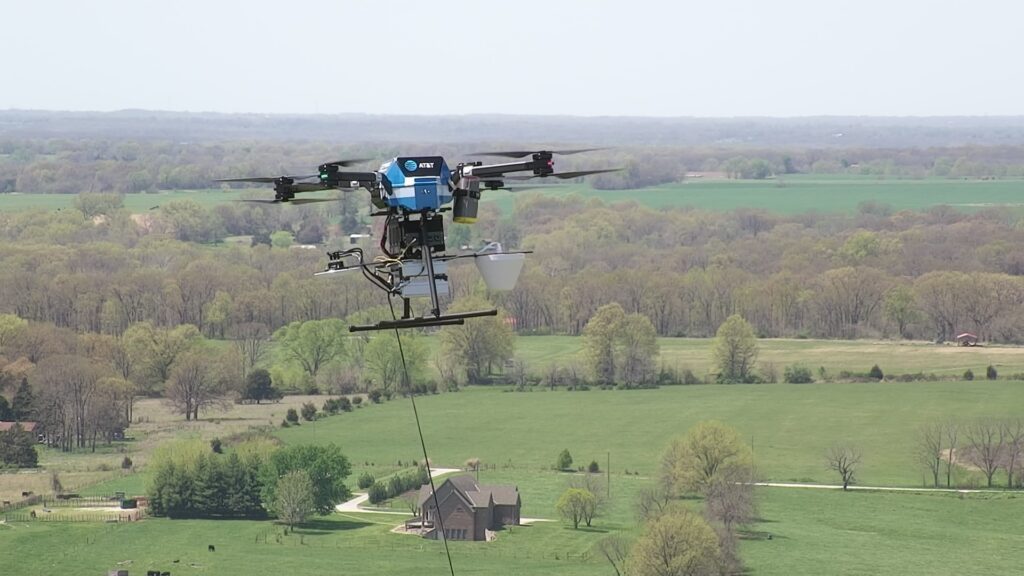
In April, the UAS division at AT&T successfully transmitted its 5G network via a drone. (Photo: AT&T)
Earlier this month, AT&T announced that their drone operations team has achieved an industry first in transmitting its 5G network via a drone. The test was performed in April in rural Missouri with AT&T’s so-called “Flying COW,” or Cell on Wings. These Flying COWs have been operating since 2017 to provide LTE connectivity over a region, explained Art Pregler, Unmanned Aircraft Systems (UAS) Program Director at AT&T.
“We can put them in the air and provide connectivity for 24 hours a day, for several days without landing, providing connectivity for people over wide areas,” he told Avionics. The company’s UAS division is focused on developing solutions that revolve around connectivity—providing connectivity both to and from drones, Pregler shared.
AT&T’s team has previously implemented a drone program that uses unmanned aircraft to inspect cell towers in the U.S. And in 2016, AT&T and NASA entered a formal agreement for UAS research that focused on air traffic management solutions. AT&T has also been involved in industry efforts to influence the development of regulations for drone operations. A representative from the company took part in the Federal Aviation Administration’s committee dedicated to making recommendations for regulating drone operations in beyond visual line of sight (BVLOS) contexts.

“5G has tremendous benefits over LTE,” says Art Pregler, AT&T’s UAS Program Director. “For example, it’s 100 times faster than 4G. Lower latency—10 milliseconds—versus 20 to 30 milliseconds with LTE.” (Photo: AT&T)
AT&T’s upgrade to 5G technology for its Flying COW came with some benefits over LTE. 5G is 100 times faster than 4G, Pregler said, which offers a better experience with upload and download speeds. Latency is also lower—10 milliseconds with 5G, compared to the 20–30 milliseconds that you get with LTE. Pregler also noted that there is a 20% overall increase in performance with 5G versus LTE, and all of these advantages enable new possibilities. “We’re pretty excited about what this opens up for us and what we can provide our customers now with these drones,” he remarked.
Following the successful test flight in April, AT&T’s UAS program is upgrading their fleet to essentially provide this 5G network via drone to customers everywhere. The 5G Flying COW is a tethered solution, Pregler stated. “We have untethered solutions, so we are planning to upgrade that as well so we can provide connectivity from orbiting drones rather than tethered drones, so these can fly long distances and stay up for long periods of time.”
The team is also working on a pseudo-satellite drone solution that would be capable of operating at an altitude of 60,000 feet to provide connectivity. This solution could also remain in operation for months at a time. It is still in development, but the pseudo-satellite vehicle may be ready to launch in a couple of years, Pregler said. Other advancements he expects to be launched in the future are tethered multi-rotor drones and vertical take-off and landing (VTOL) aircraft.
One of AT&T’s clients has requested a customized version of the 5G Flying COW solution. A drone launched over the ocean would provide a private bubble of connectivity between multiple ships. The UAS program will be demonstrating that capability in August.
Another of AT&T’s drone projects in progress involves testing beyond visual line of sight capabilities with the GEOCAST flight control system. The GEOCAST air operations framework, Pregler explained, was developed in AT&T’s own labs, and there are 45 patents behind it; “it’s a very comprehensive BVLOS system for drones,” he said. It allows remote piloting and collision avoidance in addition to precision landing. With a real-time feed, GEOCAST is also capable of avoiding certain zones and airspaces in addition to particular weather conditions.
A couple of weeks ago, the team flew a Flying COW for beyond-visual-line-of-sight operation in California, with the pilot operating the system from New Jersey. The drone in California was providing connectivity to an autonomous drone which was also flying BVLOS.
“We’re working with the FAA to get the proper approvals,” Pregler commented. “It’s a pretty challenging environment for any BVLOS operator—and it needs to be, for safety reasons.” In addition to working with the FAA, his team at AT&T is also coordinating with a UAS test site in order to get the necessary approvals.
Ethan Hunt, AT&T’s UAS Principal Program Manager, shared in the announcement that the team flew the drone at an altitude of about 300 feet, and the 5G coverage extended over roughly 10 square miles. “Drones may use 5G for command and control or to stream video, but the AT&T 5G Flying COW is the only drone that provides a 5G network,” Hunt stated.